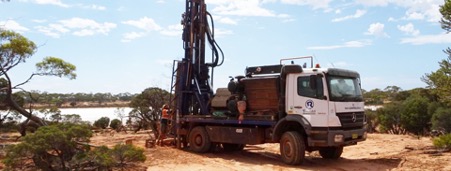Riversgold Limited (ASX: RGL) has confirmed multiple and wide, spodumene-rich mineralization in pegmatites with assay results from the drilling conducted during the last quarter of 2022 at the company’s wholly-owned Tambourah Lithium Project within the Pilbara region of Western Australia.
A total of 21 reverse circulation (RC) drill holes for 2,661m were completed at the Bengal prospect as part of Riversgold’s maiden drilling programme at Tambourah.
Twenty of the 21 drill holes intersected a cumulative total of 143m of interpreted lithium-caesium- tantalum (LCT) pegmatite. Lithium mineralization intersected is composed of a mix of spodumene and lepidolite, although a more detailed quantitative mineralization identification programme is yet to be completed.
“These drill results are the culmination of our 2022 exploration program at Tambourah and represent a significant step forward to unlocking the lithium potential of our Pilbara tenement package, located close to the globally significant Pilgangoora and Wodgina deposits,” CEO, Julian Ford, said.
“We have only really started our exploration efforts at Tambourah, and receiving the confirmation that we have pegmatites up to 14m in width with spodumene lithium mineralization is critical to us now being able to move the Project forward.
“We believe that our 2022 drilling was potentially too close to the granitic source and drilling slightly further to the east, targeting major dilation zones, will provide the consistent widths of mineralization we are after. We expect to publish the results of our extensive geochemical and geophysical results in coming weeks, which we will use to develop our drill targets for 2023.”
Sixteen of the drill holes were targeted to intersect mapped pegmatites with lepidolite outcropping at surface. The maximum width of the mapped pegmatites at surface was approximately 1.0m, with only lepidolite mineralization observed. Lepidolite is a lithium bearing, phyllosilicate mineral which is resistant to weathering. Based on rock chip mineral ratios, Riversgold postulated that the pegmatites were likely to be spodumene-rich, even though no spodumene had been identified in surface rock chips. Spodumene, as a pyroxene mineral, is far less resistant to weathering.
Mr Ford said the hypothesis was that it was likely that wider pegmatites with potential to be spodumene-rich could be present at depth. Riversgold considers that the exploration drill program was highly successful in proving the hypothesis, with the widest pegmatite width intersected 17m downhole in hole TMBRC011. The best lithium mineralization intersection was TMBRC003, being a 14m down hole intersection, within a pegmatite unit displaying a high grade spodumene core and lepidolite at its base.
Mr Ford said the company noted that the maiden Tambourah lithium exploration drill program successfully validated that the Bengal pegmatite system is a spodumene-rich LCT system where fresh subsurface pegmatite is significantly broader than the narrow, weathered surface outcrop. More importantly, the company has confirmed that the dominant mineralization species is spodumene.
The five remaining drill holes were designed to test the validity of the previously completed DGPR survey where no surface outcrop is visible, but subsurface similarly orientated anomalies were postulated to be buried pegmatites. Results for those five test drill holes are encouraging with four out of the five holes confirming the DGPR interpretation by intercepting pegmatite, with the fifth hole intersecting a fault zone rather than a pegmatite.
The successful use of DGPR in identifying buried pegmatite is a material breakthrough given that as Riversgold’s exploration activities at Tambourah move eastward, the expectation is that more spodumene and less lepidolite mineralization will be encountered, meaning there will likely be no surface expression of these pegmatites.
For further information please visit: https://www.riversgold.com.au/












